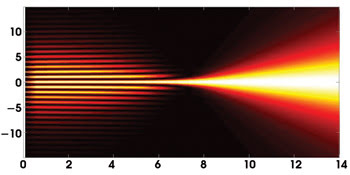
A Different Kind of Superlens
Specially scribed transparent plates may lead to λ/100 resolution.
Hank Hogan
Investigators have been searching for the perfect lens, or at least one that can image far below the wavelength of the source light. In addition to being useful in research, such a lens could find a home in semiconductor nanolithography, in increasing the capacity of optical storage disks, or in allowing an inexpensive red laser to have the resolution of a more costly blue one.

In this plot of calculated intensity, the focusing of an evanescent field is shown. The interference of neighbors on the central point, marked with a 0, keeps the beam from spreading until the neighbors die away, determining the focal length — in this plot, somewhere between 6 and 8. Courtesy of Roberto D. Merlin, University of Michigan.
One of the most promising recent attempts involved materials that have a negative index of refraction — that is, substances that bend light in a direction opposite to that of more common matter. However, such materials are negative over only a sometimes small range of wavelengths and often suffer high light losses, making it difficult to build practical lenses with them.
Now Roberto D. Merlin, a professor of physics and of electrical engineering and computer science at the University of Michigan, Ann Arbor, has another solution: transparent plates with a set of opaque concentric circles with clear spaces in between. The edges of the circles would be spaced far apart at the center of the plate but come closer together at the plate’s outer edge, with the spacing modulated in a carefully chosen way. Merlin’s calculations show that, if properly fabricated, these plates would act as lenses for the evanescent, or near, field.
Because this approach does not involve the traveling waves that form the basis for conventional optics, lenses based on such a method would sidestep conventional resolution limits and should achieve a resolution that is the wavelength divided by 100 or more, depending on the frequency range. When compared with light losses in other subwavelength schemes, those in this method appear to be less, meaning that imaging would be easier.
The focal length of the near-field lenses would be short because evanescent waves do not travel far. Merlin noted that the resolution within the near field would be given by the characteristic length of the structure, which imposes certain fabrication requirements. “If you want to have a resolution of 10 Å, you have to know how to make lines and features on your plate that are 10 Å.”
He added that the features required for a resolution of 200 Å are attainable with current technology. Although the work so far has been theoretical, Merlin reported that he and other researchers are building a microwave version of the concept that should be completed soon. He also noted that it should be possible to achieve resolutions of the wavelength divided by 100 in that range, given current fabrication technology. At optical wavelengths, the best resolution now possible should be the wavelength divided by 10.
Science Express, July 12, 2007, doi: 10.1126/science.1143884.
Published: September 2007